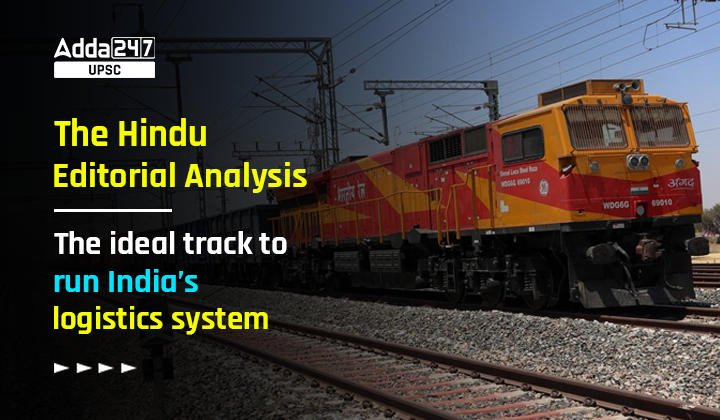Table of Contents
The Hindu Editorial Analysis: The editorial analysis of The Hindu Newspaper Editorial Articles aimed at simplifying various concepts relevant to the UPSC and other State PSC Exams. The Editorial Analysis helps in expanding the knowledge base as well as framing better quality mains answers. Today’s Hindu Editorial Analysis discusses about the Ideal Track to Run India’s Logistics System leading to efficient and fast economic growth and development.
India’s Logistics System in News
The recently released Union Budget 2023 has doubled the PM Gati Shakti National Master Plan to States from ₹5,000 crore to ₹10,000 crore. The Union Budget 2023 has announced an outlay of ₹2.4 lakh crore for the Indian Railways.
Indian Railways and PM Gati Shakti Plan
The PM Gati Shakti plan is a transformative approach for economic growth and sustainable development dependent on the engines of roads, railways, airports, ports, mass transport, waterways and logistics infrastructure.
- The Railways offer an efficient and economic mode of logistics movement given their pan-India network, and can play an important role in enabling a coordinated and integrated logistics system.
- PM Gati Shakti has a target of increasing the share of the railways in freight movement from 27% to 45% and increasing freight movement from 1.2 billion tonnes to 3.3 billion tonnes, by 2030.
- With this, PM Gati Shakti provides the right platform to address the infrastructural challenges that have hampered the movement of freight by rail.
Skewed Share of Road Transport
Currently, the modal mix in terms of freight movement in India is highly skewed in favour of road transport, with 65% of freight movement by road.
- The effect is an increased burden on roads, and, therefore, significant congestion, increased pollution, and resultant logistics cost escalations.
- A look at the comparable costs of different forms of transportation suggests that freight movement cost is the highest in the road sector — nearly twice the rail cost.
- However, the convenience of road transport has taken precedence over cost, and the railways in India have been losing freight share to other more flexible modes.
- In 2020-21, coal constituted 44% of the total freight movement of 1.2 billion tonnes, followed by iron ore (13%), cement (10%), food grains (5%), fertilizers (4%), iron and steel (4%), etc.
- Transportation of non-bulk commodities accounts for a very small share in the rail freight movement.
Rise in container traffic
In India, the convenience of moving non-bulk commodities in containers has led to an increase in containerised traffic over the last decade, growing from 7.6 million Twenty-foot Equivalent Unit (TEU)s in 2008 to 16.2 million TEUs in 2020. TEU is a unit of cargo capacity.
- Globally, railway systems are heavily investing in advanced rail infrastructure for quick and low-cost container movement.
- For example, China uses special trains to carry containers that connect significant ports to the inland, and has dedicated rail lines to move container traffic and planned double-decker container carriages for greater efficiency.
Other Challenges Faced by Indian Railways
The national transporter faces several infrastructural, operational and connectivity challenges, in turn leading to a shift of freight traffic to roads.
- The increased transit time by rail and pre-movement and post-movement procedural delays such as wagon placement, loading and unloading operations, multi-modal handling, etc., hamper freight movement by rail.
- The lack of necessary terminal infrastructure, maintenance of good sheds and warehouses, and uncertain supply of wagons are some of the infrastructural challenges that customers face.
- This results in high network congestion, lower service levels, and increased transit time.
- The absence of integrated first and last-mile connectivity by rail increases the chances of damage due to multiple handling and also increases the inventory holding cost.
Way Forward
The increased adoption of the railways as a mode for cargo movement is crucial to improve India’s logistics competitiveness.
- The upcoming Dedicated Freight Corridors along India’s eastern and western corridors and multimodal logistics parks will ease the oversaturated line capacity constraints and improve the timing of trains.
- Establishing a special entity under the railways to handle intermodal logistics in partnership with the private sector will help in addressing the first and last-mile issue faced by the railways.
- The entity could function as a single window for customers for cargo movement and payment transactions.
- There are two cargo wagons in each passenger train. Based on industry recommendations, introduction of an Uber-like model for one of the two cargo wagons, wherein the customer can book the wagon using an online application, could help in increasing the utilisation rate of these wagons.
- The Indian Railways may keep operating the other wagon, the way it is done currently, until the success of the proposed model is established.
- This could directly increase freight traffic without any additional investment in infrastructure.
- An integrated logistics infrastructure with first and last-mile connectivity is essential to make rail movement competitive with roads, and facilitate exports by rail to neighbouring countries such as Nepal and Bangladesh.
Conclusion
The Indian Railways need to improve infrastructure that is backed by adequate policy tools and also encourage private participation in the operation and management of terminals, containers, and warehouses to efficiently utilise resources.



 TSPSC Group 1 Question Paper 2024, Downl...
TSPSC Group 1 Question Paper 2024, Downl...
 TSPSC Group 1 Answer key 2024 Out, Downl...
TSPSC Group 1 Answer key 2024 Out, Downl...
 UPSC Prelims 2024 Question Paper, Downlo...
UPSC Prelims 2024 Question Paper, Downlo...
